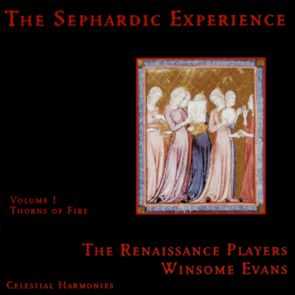 |
||||||||||||||||||||||||||||||||||||||||||||||||

the projectThe Sephardic Experience quadrilogy, is a priceless
sound document in which the Renaissance Players present their own
performance versions of well– and lesser–known romansas
(ballads), kantigas (religious songs) and muwashshahat
(poetical forms) which have survived for centuries entirely via oral/aural
transmission by parents, grandparents, friends and acquaintances within
the family circle, while working, or as a form of ad hoc entertainment
in Sephardic communities of the West and East. Sadly, as the end of
the 20th century draws near we are witnessing the alarming disappearance
of Spanish–Jewish culture due to vast, worldwide changes in social
circumstances. In fact, these songs are no longer a part of the rich,
musical fabric of the everyday life of the Sephardim.
As was the case in the middle ages for many types of traditional music, the lyrics of the Sephardic romansa, kantiga, muwashshah and zajal could be sung to a newly composed melody or to a pre–existing melody from either secular or liturgical repertoires. In traditional Sephardic singing one does not hear heavy and constant vibrato or long–held notes which are not decorated. Furthermore, there is a firmly blended fusion of Spanish–Arabic qualities both in the sound of the melodies and the way they are treated in performance. The main themes in this first volume, Thorns of Fire, relate to the rose as a symbol of love; with weddings and various associated customs; with delightful, ravishing Muslim girls; and with the omnipresent force of the sea and the siren. The Sephardic romansas and kantigas featured in this volume are from sources in Andalusia, Rhodes, Balkans, the Orient, Bulgaria and Tetuan, and the dance songs come from Macedonia, Andalusia and Australia. Also featured is a single declaimed Biblical text, linked by theme and concept, accompanied by entirely improvised, taksim–like instrumental commentary. the artistsThe Renaissance Players is the longest standing professional
Early Music ensemble in Australia. Founded in 1967 by Winsome Evans,
the ensemble is well–known for its varied and imaginative concert
programs which are presented in costume and enlivened by poetry, mime,
dance and processions. They perform a wide range of music dating from
the 9th century through contemporary folk and classical styles, using
replicas of, and/or ethnically, authentic instruments where possible
and attempting to reproduce performance styles appropriate to whatever
music is played. The Renaissance Players have a library of over 2,500
pieces, which have all been collected, arranged and/or composed by
Winsome Evans.
Winsome Evans, Director of the Renaissance Players, is also the producer of this series. Aside from the performance and dance schedule of the Renaissance Players, Winsome teaches music at the University of Sydney and is one of Australia's busiest harpsichordists. She has mastered an additional 25 wind, string, percussion and keyboard instruments. Members of The Renaissance Players performing on this recording include Winsome Evans, Benedict Hames, Llew Kiek, Mara Kiek, Melissa Irwin, Mina Kanaridis, Andrew Lambkin, Barbara Stackpool, and poetry reader Geoff Sirmai. biography - winsome evansbiography - the renaissance playersdiscography - the renaissance playerstracklist
|
||||||||||||||||||||||||||||||||||||||||||||||||
|
|
||||||||||||||||||||||||||||||||||||||||||||||||
 |



